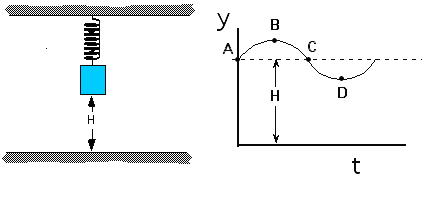A2L Item 052
- Description: Identify position where spring force is maximum.
- Goal: Reasoning and comparing the sizes of forces.
- Source: UMPERGA block attached to the end of a spring is hanging at rest from the
- Keywords: Forces, Graphing, Mechanics, Reasoning, Springs
The question for students:
A block attached to the end of a spring is hanging at rest from the ceiling as shown at the left below. After the block is pulled down and released it moves up and down for an extended period of time. The motion during one cycle is shown in the graph at right below.

Several points are indicated on the graph. At which point is the spring force exerted on the block the greatest?
- Point A
- Point B
- Point C
- Point D
- Points B and D
- Points A and C
- The spring force is always the same
- None of the above
- Cannot be determined
Commentary for teachers:
Answers
(4). The spring force is largest at the position where it is compressed or stretched the most relative to its natural length. The spring is already stretched when it is at a height H because there must be an upward spring force to balance the gravitational force on the block. As the height of the block is decreased the spring is stretched further. As the height of the block is increased the spring is stretched less - if raised enough the spring would start to compress.
Background
Many students will attempt to apply the spring force law without real understanding. This problem requires students to understand the physical situation and to interpret graphical information about the height of the block to reason out an answer.
Questions to Reveal Student Reasoning
What is the force law for a spring? How does the spring force compare to the weight of the block? At what points is the spring stretched? … compressed?
Suggestions
Demonstrate with a spring that a vertical spring stretches when a weight is attached. Show that as the weight moves up and down that the spring need never get back to its natural length (i.e., it is always stretched)
Draw free-body diagrams, especially for points B and D.